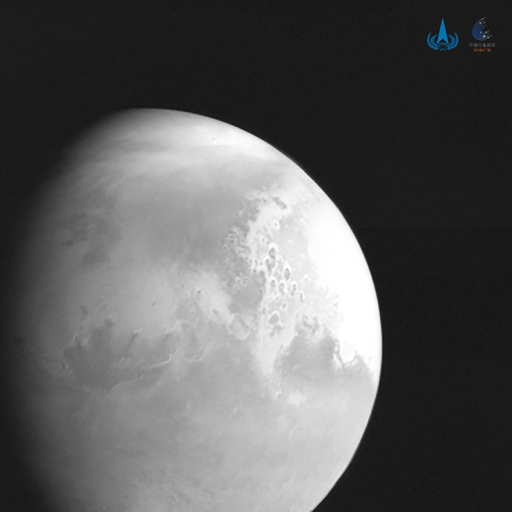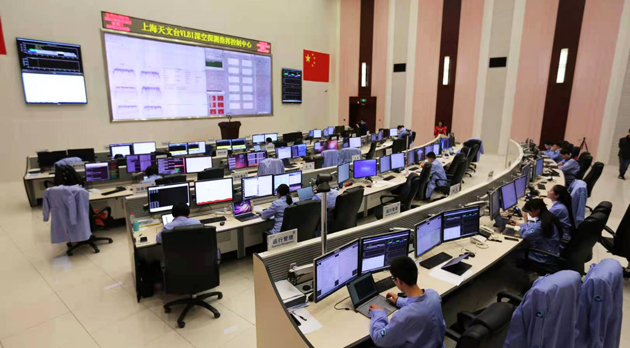By SONG Jianlan (Staff Reporter)
On the night of February 10, a time when the Chinese people are awaiting the advent of the Year of the Ox, Tianwen-1, the first Mars probe of China, brakes and slows down to enter the Red Planet’s gravity field safe and sound. Days ago, it just hit headlines once again by sending back the first photo of Mars it shot when approaching the destination, after experiencing a fourth orbital adjustment to end its cruise and transfer to the Mars orbit.

The first photo of Mars shot by Tianwen-1, the maiden Mars probe of China, when approaching the Red Planet around 2,200 thousand kilometers away. (Credit: CNSA)
In the following days, Tianwen-1 is set to orbit the Red Planet for a global survey and observation. Before it can transfer into the Mars orbit, the probe must perform a series of critical orbital adjustments to stay at optimal conditions, and every nuance change in power and thrust means a lot.
Behind these critical maneuvers made by this shining star, stands a low-profile escort. One might not even notice its silent accompany in the background. Yes, it is the Chinese Very Long Baseline Interferometry Network (CVN) that has been helping with measuring the loci of the Chinese Mars probe in quasi-realtime throughout its journey, from the first to the last orbital adjustment. Taking advantage of a technology called very long baseline interferometry (VLBI), it can combine measurements of the same object made by different telescopes distributed far away from each other to give the exact visual angle of the object at a very sharp resolution – just as if it is using a virtual telescope whose aperture is as big as the distance between the two farthest terminals in the network, or the longest baseline in the network.
Originally built for astronomical observation of celestial bodies like quasars and galaxies thousands of light years away from the Earth, the VLBI system is highly sensitive to the angular variations of remote objects in the direction perpendicular to our line of sight. By accurately measuring the time delay, or the difference in arrival time between multiple telescopes receiving signals from the same source, and the time delay rate (the rate at which the time delay fluctuates), the system can tell very small angular variations of the source. Given this excellent sensitivity, it can help improve the accuracy of orbit determination for a spacecraft in flight.
While Tianwen-1is flying to Mars, this system can accurately measure and calculate the probe’s angular variations in quasi-realtime, and finally help determine its current position by reporting to the central console of the mission the time delays, the time delay rate, the right ascensions and the declinations, etc. The mission’s central console will give the probe instructions to adjust its own velocity to achieve ideal loci, based on its current location and velocity. Therefore, knowing the precise position of the probe is a precondition for determining and adjusting its orbit. Particularly when approaching Mars and getting captured by its gravity, this man-made spacecraft has to adjust its velocity and attitude swiftly at a very accurate level to make sure it enters Mars orbit at a prompt point and a right velocity – all based on its current position per se. While moving at a very fast velocity, even a minor error in thrust could invite disastrous consequences in its course, therefore the measurement and corresponding data processing have to be highly precise and, quick.
Given that in February Tianwen-1 is set to end its cruise to start orbiting Mars, and later in May to land on the Mars surface to accomplish in situ scientific investigations – all the processes involve complicated maneuvers that require frequent, delicate adjustments in velocity and attitude – during these critical episodes the CVN will face an ordeal as it is expected to provide accurate data in quasi-realtime every day.

The CVN central console located in the Shanghai Astronomical Observatory. (Credit: SHAO)
Actually, it is not the first time for the CVN to play such an instrumental role in a space exploration: it has seen through all the Chang’e probes navigating to and from the Moon. But this time, different from Lunar missions, its task is much more challenging.
At least, Mars is much farther than the Moon: the apogee of its orbit is about 400 million kilometers from the Earth, roughly 1,000 times that of the Moon. The much longer distance asks for much better an angular resolution, as the same angular error means much bigger error in linear velocity as well as displacement, compared with an object within a much shorter distance. On the other hand, the distance also means a longer time needed for signal transmission and hence larger loss and time delay. To secure a safe flight to its destination, Tianwen-1 demands accurate orbit determination almost in the meantime of its moving, therefore the time delay allowed for measurement and calculation cannot exceed 10 minutes – for a network used to observe “static” celestial bodies, this poses a new challenge.
With the 65-m aperture radio telescope Tianma (meaning “heaven horse” in Chinese), the biggest of Asia, joining in the network in 2012, the CVN now has a total of four telescopes. Aside from Tianma, which is located at the Sheshan Mountain Station in Shanghai, the network includes a 25-m aperture radio telescope located at Urumqi station, Xinjiang Uygur Autonomous Region, western China, a 50-m aperture one at Beijing station and a 40-m one at Kunming station, southwestern China. The ones between Urumqi and Shanghai form the longest baseline of the network, measuring over 3,000 kilometers. Each station is equipped with a highly stable hydrogen atomic clock, a signal receiver for the Global Navigation Satellite System and other devices, to help them stay synchronized in observations via the Internet. The “brain” of this observation network, the central processor, is located in and administered by the Shanghai Astronomical Observatory (SHAO), Chinese Academy of Sciences.

The 65-m aperture radio telescope Tianma (meaning “heaven horse” in Chinese), the biggest of Asia, joins the network in 2012. (Credit: SHAO)
To meet the extremely tough requirements in data quality, the CVN completed an overhaul and update in its system by July 2020, including the R&D, testing and installment of over 40 sets of software and hardware. The CVN team carefully mapped out a detailed plan for the implementation of prospective measurement, and scrutinized and examined the operation of equipment at all four stations. Their efforts are paid off. So far, the system has performed 106 measurements, and the output data has far overperformed the preset standards: it can differentiate a time delay as small as 0.1 nanosecond in radio transmission between two telescopes, with an error in time delay rate of no more than 0.3 picosecond per second. This excellent performance offers it a very sharp resolution in imaging the object’s angular variations.
The fast flying Tianwen-1 knows what this resolution means – every inch of its progress matters.

